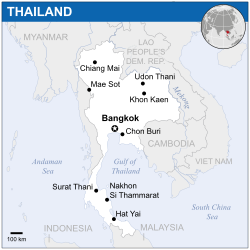Tailandya
Tagboan: 15°24′N 101°18′E / 15.4°N 101.3°E
| Kahadean nin Tailandya ราชอาณาจักรไทย (tataramon?) Ratcha-anachak Thai | |
|---|---|
![Lokasyon kan Tailandya (green) in ASEAN (dark grey) – [Legend]](http://upload.wikimedia.org/wikipedia/commons/thumb/b/b8/Location_Thailand_ASEAN.svg/250px-Location_Thailand_ASEAN.svg.png) | |
 | |
| Kapitolyo and Pinakadakulang Syudad | Bangkok 13°45′N 100°29′E / 13.750°N 100.483°E |
| Opisyal na mga tataramon | Thai[1] |
| Spoken languages | |
| Mga etnikong grupo (2009;[6] 2011[3]Plantilya:RP) |
|
| Relihiyon |
|
| Demonym | Thai Siamese (archaic) |
| Gobyerno | Unitary parliamentary constitutional monarchy |
• Monarch | Maha Vajiralongkorn |
| Srettha Thavisin | |
| Lehistratura | National Legislative Assembly (acting as National Assembly) |
| Formation | |
| 1238–1448 | |
| 1351–1767 | |
| 1768–1782 | |
| 6 April 1782 | |
| 24 June 1932 | |
| 6 April 2017 | |
| Area | |
• Total | 513,120 km2 (198,120 sq mi) (50th) |
• Tubig (%) | 0.4 (2,230 km2) |
| Populasyon | |
• 2016 tantya | 68,863,514[8] (20th) |
• 2010 Sensus | 64,785,909[9] |
• Densidad | 132.1/km2 (342.1/sq mi) (88th) |
| GDP (PPP) | 2018 tantya |
• Kabuuhan | $1.296 trillion[10] |
• Per capita | $18,734[10] |
| GDP (nominal) | 2018 tantya |
• Kabuuhan | $514.700 billion[11] |
• Per capita | $7,588[11] |
| Gini (2013) | 37.8[12] medium |
| HDI (2015) | high · 87th |
| Currency | Baht (฿) (THB) |
| Sona nin Oras | ICT (UTC+7) |
| Nagmamaneho sa | left |
| Kodang pan-apod | +66 |
| Internet TLD | |
An Tailandya (sa Ingles: Thailand) o Kahadean nin Tailandya sarong nasyon sa Asya.
Toltolan[baguhon | baguhon an source]
- ↑ Thailand Archived 3 July 2015 at the Wayback Machine., The World Factbook.
- ↑ Draper, John; Kamnuansilpa, Peerasit (2016). "The Thai Lao Question: The Reappearance of Thailand’s Ethnic Lao Community and Related Policy Questions". Asian Ethnicity. doi:. Archived from the original on 27 December 2016. https://web.archive.org/web/20161227040923/http://www.tandfonline.com/doi/full/10.1080/14631369.2016.1258300. Retrieved on 23 November 2016.
- ↑ 3.0 3.1 International Convention on the Elimination of All Forms of Racial Discrimination; Reports submitted by States parties under article 9 of the Convention: Thailand (PDF) (in English with appended Thai government translation). United Nations Committee on the Elimination of Racial Discrimination. 28 July 2011. Archived (PDF) from the original on 9 October 2016. Retrieved 8 October 2016.
- ↑ David Levinson (1998), Ethnic Groups Worldwide: A Ready Reference Handbook, Oryx Pres, p. 287, ISBN 1-57356-019-7
- ↑ Paul, Lewis M.; Simons, Gary F.; Fennig, Charles D. (2013), Ethnologue: Languages of the World, SIL International, ISBN 978-1-55671-216-6, archived from the original on 27 December 2007
- ↑ Barbara A. West (2009), Encyclopedia of the Peoples of Asia and Oceania, Facts on File, p. 794, ISBN 1-4381-1913-5
- ↑ "Population by religion, region and area, 2015" (PDF). NSO. Archived (PDF) from the original on 10 December 2017. Retrieved 12 October 2017.
- ↑ "World Population Prospects: The 2017 Revision". ESA.UN.org (custom data acquired via website). United Nations Department of Economic and Social Affairs, Population Division. Retrieved 10 September 2017.
- ↑ Plantilya:Th icon National Statistics Office, "100th anniversary of population censuses in Thailand: Population and housing census 2010: 11th census of Thailand" Archived 12 July 2012 at the Wayback Machine.. popcensus.nso.go.th.
- ↑ 10.0 10.1 "Thailand". International Monetary Fund. Archived from the original on 28 March 2018. Retrieved 29 January 2018.
- ↑ 11.0 11.1 "Thai Economic Performance in Q4 and 2017 and Outlook for 2018". National Economic and Social Development Board. Archived from the original on 22 February 2018. Retrieved 21 February 2018.
- ↑ "Gini Index". World Bank. Archived from the original on 4 December 2017. Retrieved 3 December 2017.
- ↑ Global 2016 Human Development Report Overview – English (PDF). New York: United Nations Development Programme (UNDP). 2017. pp. 22–24. Archived (PDF) from the original on 23 March 2017. Retrieved 22 March 2017.
Mga kategorya:
- Webarchive template wayback links
- CS1 maint: Unrecognized language
- Coordinates on Wikidata
- Mga artikulo na naglalaog nin teksto sa tataramon na Thai
- Mga artikulo na naglalaog nin teksto sa tataramon na explicitly cited English
- Pages using infobox country or infobox former country with the symbol caption or type parameters
- Mga tamboan na artikulo
- Mga nasyon sa Asya



